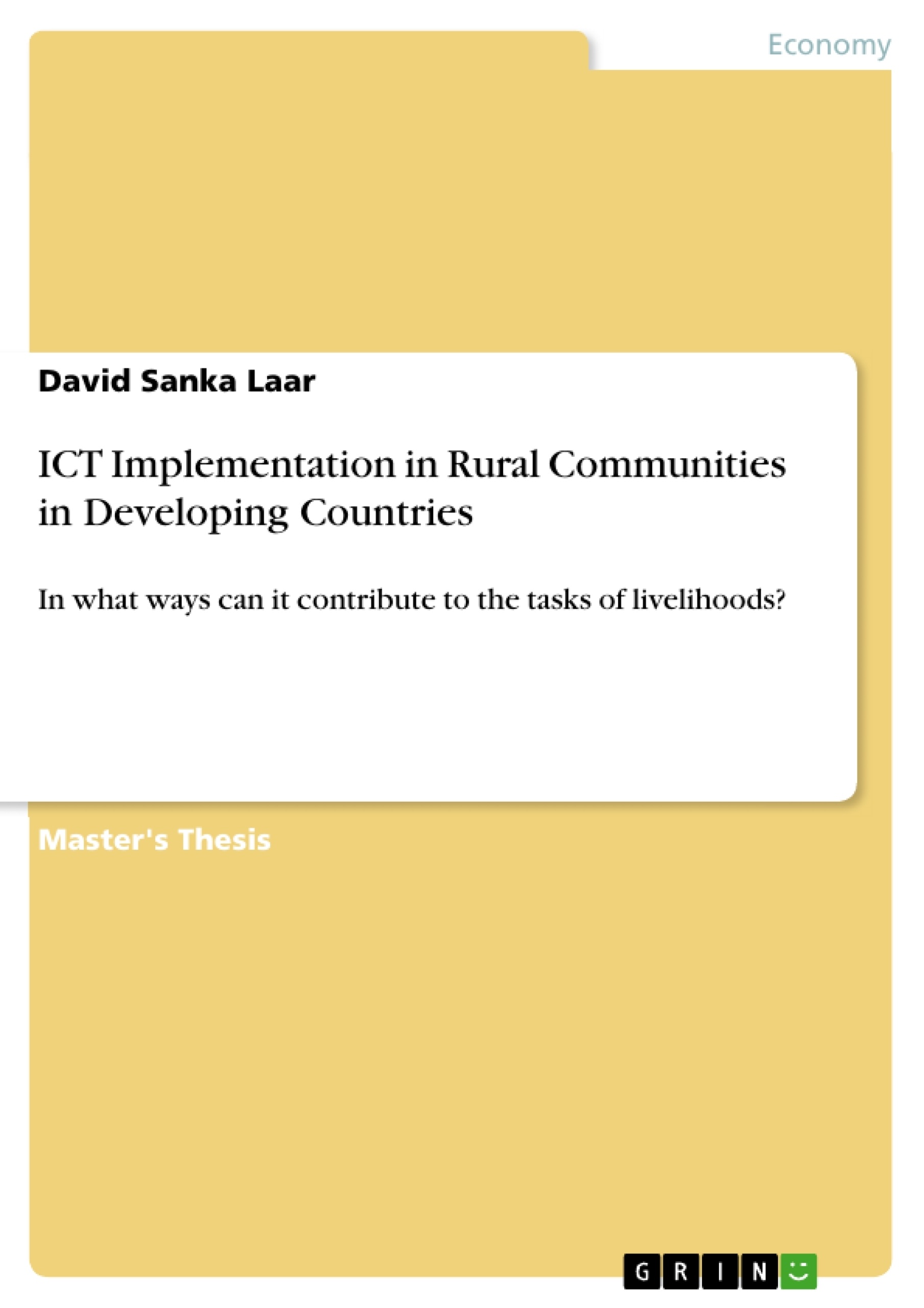There has been a gamut of arguments concerning the role of information and communication technologies in reducing poverty and creating sustainable rural development in developing countries. But most of the studies have centred on case study descriptions, with a handful attempting to analyse the outcomes of these initiatives using a framework that addresses the multiple dimensions of the livelihoods of the rural poor. This dissertation takes a view that ICT can contribute to sustainable rural development when it is implemented and assessed through such a framework geared at building the capabilities and assets of the rural folks and improving the links within and between these people and the organisations and institutions that play a role in rural development. It reviews various paradigms of rural ICT in developing countries and goes on to analyse the implementation and contribution of two of such initiatives to rural livelihoods using the Sustainable Livelihoods Framework. The result revealed that such factors, as the perceptions of practitioners, political contentions and policy environments are the major factors shaping ICT initiatives for the rural poor.
Inhaltsverzeichnis (Table of Contents)
- Chapter 1 : INTRODUCTION
- 1.1 BACKGROUND
- 1.2 RESEARCH OBJECTIVES AND QUESTIONS
- 1.3 RELEVANCE OF THE RESEARCH
- 1.4 RESEARCH METHODOLOGY
- 1.5 RESEARCH STRUCTURE
- 1.6 SUMMARY
- Chapter 2 : PERSPECTIVES ON ICT AND ON RURAL DEVELOPMENT
- 2.1 INTRODUCTION
- 2.2 THE CONCEPT OF ICT
- 2.2.1 Definition
- 2.2.2 The Technical View of ICT
- 2.2.3 The Socio-technical view of ICT
- 2.3 THE CONCEPT OF RURAL DEVELOPMENT
- 2.4 SUMMARY
- Chapter 3 : MARRIAGE OF ICT AND RURAL COMMUNITIES
- 3.1 INTRODUCTION
- 3.2 THE CONTEXT OF RURAL COMMUNITIES IN DCS
- 3.3 MODES OF ICT IMPLEMENTATION IN RURAL COMMUNITIES
- 3.3.1 Drivers
- 3.3.2 Deliverables
- 3.3.3 Strategies
- 3.3.4 Cross-cutting issues
- 3.4 THE POTENTIAL ROLE OF ICT IN RURAL LIVELIHOODS
- 3.4.1 ICT in the Sustainable Livelihoods Framework
- 3.4.2 ICT and Livelihood Assets
- 3.4.3 ICT and Transforming structures and Processes
- 3.4.4 ICT and Vulnerability Context
- 3.4.5 ICT and Livelihood Strategies
- 3.4.6 ICT and Livelihood Outcomes
- 3.5 SUMMARY
- Chapter 4 : REAL WORLD EXPERIENCE WITH RURAL ICT INITIATIVES
- 4.1 CASE STUDIES OVERVIEW
- 4.1.1 The Gyandoot e-Government Portal in India
- 4.1.2 The Centre of Informatics of the University Eduardo Mondlane (CIUEM) Rural Telecentre initiative in Mozambique
- 4.2 ANALYSIS
- 4.2.1 Paradigms or Modes of ICT Initiatives in Practice
- 4.2.2 ICT Initiatives and Rural Livelihoods
- 4.2.2.1 ICT and Livelihood Assets and Strategies
- 4.2.2.2 ICT and Transforming Structures and Processes
- 4.2.2.3.Vulnerability Context
- 4.2.2.4. ICT and Livelihood Outcomes
- 4.3 SUMMARY
- The role of ICT in rural development
- The impact of ICT on livelihoods in rural communities
- The challenges and opportunities of ICT implementation in rural areas
- The importance of a socio-technical approach to ICT implementation
- The need for a sustainable and inclusive approach to rural ICT initiatives
Zielsetzung und Themenschwerpunkte (Objectives and Key Themes)
This dissertation investigates the potential of Information and Communication Technologies (ICT) implementation in rural communities of developing countries to contribute to their livelihoods. It aims to explore the relationship between ICT and rural development, specifically focusing on how ICT can contribute to sustainable livelihoods and address vulnerabilities faced by these communities.
Zusammenfassung der Kapitel (Chapter Summaries)
Chapter 1 provides an introduction to the research, outlining the background, objectives, research questions, methodology, and structure. It emphasizes the importance of exploring the benefits of ICT in rural communities and the need to move beyond the debate of whether ICT is a luxury or a necessity for the poor.
Chapter 2 examines the concepts of ICT and rural development, focusing on the technical and socio-technical aspects of ICT. The chapter also explores different perspectives on rural development and the challenges faced by rural communities in developing countries.
Chapter 3 delves into the potential role of ICT in rural livelihoods, examining the integration of ICT into the Sustainable Livelihoods Framework. It discusses how ICT can impact various livelihood assets, transform structures and processes, address vulnerabilities, and contribute to sustainable livelihoods.
Chapter 4 presents real-world examples of rural ICT initiatives in India and Mozambique, analyzing the drivers, intended deliverables, strategies, and outcomes of these projects. The chapter highlights the challenges and successes of implementing ICT in rural settings, including issues related to infrastructure, social factors, and sustainability.
Schlüsselwörter (Keywords)
This work focuses on ICT implementation in rural communities in developing countries, examining its potential to contribute to livelihoods. Key concepts include sustainable livelihoods, vulnerability context, socio-technical systems, ICT-enabled rural development, and the importance of inclusive and empowering ICT initiatives.
- Quote paper
- David Sanka Laar (Author), 2005, ICT Implementation in Rural Communities in Developing Countries, Munich, GRIN Verlag, https://www.grin.com/document/312470



